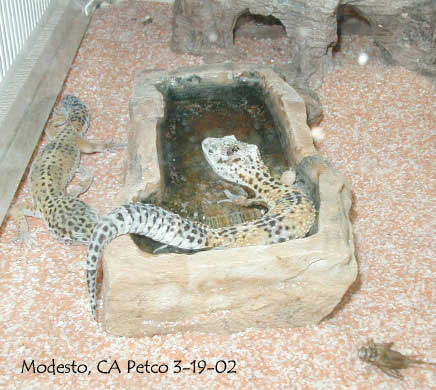
Hi, my name is ERiC Miller and these pics are from the Petco store in Modesto, California. They're pretty bad and they always have been since they moved in a few years back. In case anyone is wondering right off, they buy their reptiles from the California Zoological Society. Now there is one improvement I can tell you of at this store: they have care sheets for all of their animals to give out to new owners. The problem is the employees don't seem to bother reading them at all. I will be offering several examples.
Now I was at this store the day before i took these pictures during feeding time. The gecko in the water dish in picture #1 was shedding at the time. it was having a hard time as none of the reptiles have moist hide spots. First example - Petco Leopard Gecko Proper Care sheet states: "Use a humid hide area with damp moss if any shedding problems are noticed." All the leopard geckos in the store had unshed skin on them. This gecko also had calci-sand clumped all over it's skin it was shedding (and eating). That's bad if you didn't know. You can also see in this picture it has unshed skin on the top of it's head, which is also pretty bad. This cage also houses 2 other geckos and is of a good size and not as dirty as the other cages. Oh, and the cricket in picture #1 is dead.
#1

This next enclosure in picture #2 I think was the worst. The baby leopard geckos are all underfed, have unshed skin on them and the cage is obviously filthy. Second Example - The Petco Leopard Gecko Proper Care sheet it states in bold letters: "Juvenile leopard geckos must always have a bowl of small mealworms availible 24 HOURS A DAY. They need to be dusted with CALCIUM/vitamin supplement." [emphasis theirs]. As you can plainly see, the mealworm dish is empty.
#2

Picture #3 is another picture of the cage in #2. About 4 months ago I counted 30 hatchling leopard geckos piled on top of each other in this tiny cage. The few that are left have not grown at all in that time. Example Third - The Petco Leopard Gecko Proper Care sheet states: "A dozen hatchling leopard geckos will comfortably live in a ten to twenty gallon aquarium." (It doesn't however state anything about adult geckos.) In this tank, which I guess to be no more than 4-5 gallons, they had 30. It now appears to be down to 8-10. Again I have to point out the bad condition of the gecko's skin. About a year ago I mentioned the lack of humid hides and all the unshed skin on the geckos to the staff. I was repeatedly told "But we mist them..." and the next time I came in they had a lame attempt at a humid hide in 1 of the tanks. It's gone now.
#3
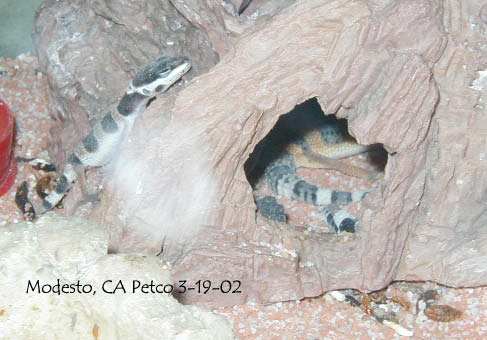
This next thing is something I see often in pet stores and I'm not entirely sure of what the deal is. This geckos eyes are swollen shut. All of the older Leopard Geckos had similar eyelid swelling. Possibly a side affect of not having a moist hide area.
#4
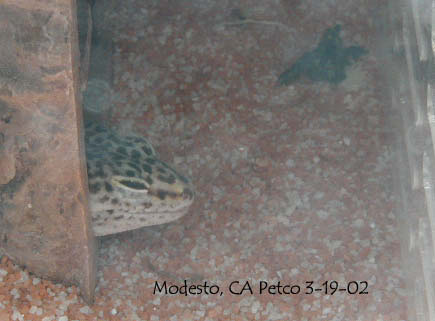
What I saw in the tank in #5 just plain freaked me out. That is a fully grown adult male leopard gecko housed in a 4-5 gallon enclosure with 4 hatchlings. (How old the little ones were I'm not sure. As old as 3-5 months possibly as in pics #2 and #3, so not really quilifying them as hatchlings. But they have been so underfed their growth is horribly stunted.) As I mentioned before I stopped by once during feeding time. The Petco Leopard Gecko Proper Care sheet says this about food: "Crickets can also be fed, as long as they are no larger than half the size of the gecko's head." The only live food they fed their reptiles was 3/4" crickets. These were far too large for these little geckos. As I watched the employee dump in about 5 3/4" crickets, the adult gecko immediately ate them all up. The little guys had no chance at the food that was too big for them to eat anyway. So these stunted growth babies are starving to death, with no hide boxes (humid or otherwise) and are also in mortal danger of being eated by the adult male in the cage with them. This is not a satisfactory state of affairs.
#5

#6 is not really about bad housing exactly. I didn't count how many iguanas they had in there, but I think there were about 20 and this Petco seems to sell a lot of them. I only mention this because a few months back just about a half mile from this store at least 3 iguanas, that I know of, were abandoned on the Modesto Junior College West Campus. Not all at the same time, but in the same place. Good grief, stop selling these things people.
#6
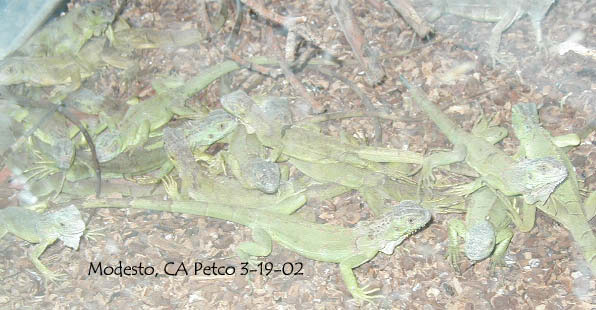
A Quick Update:
Thursday October 24th, 2002. I went back into this same Petco to see how things were getting on. I knew they wouldn't be well, as they never had been. Well, I wasn't quite prepared for what I did see in the following picture...
#7
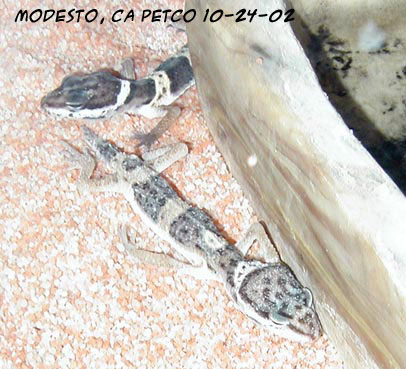
Yes, that is a scrawny live gecko on top and a scrawny dead gecko on bottom. It looked pretty stiff and had probably been there at least a day, if not longer. You may also notice the calcium sand, which can be bad for adult reptiles and dangerous for babies. These geckos may even be the same ones from picture #'s 2 and 3. They are so underfed it's hard to say.
#8
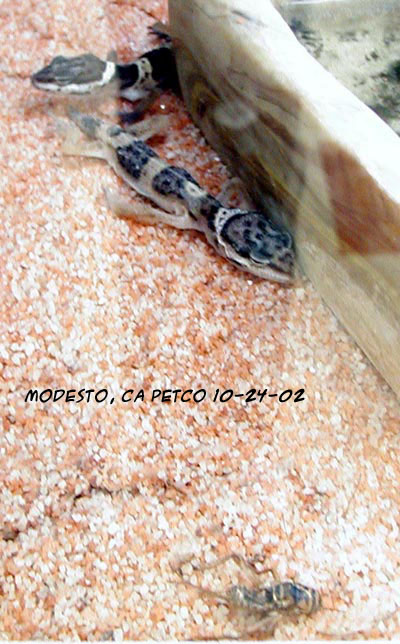
You can see in picture #8 what these little geckos were being fed: 3/4" crickets. The scale may appear a little off in this picture as the cricket is much closer to the camera than the gecko, but trust me, it was too big for this size gecko. I've seen a Petco employee at this store feed 10 baby geckos a total of 3 crickets which were far too large for any of them to eat. This is a result of such shameful neglect. An employee asked if I needed any help and I told her no, but that there is a dead lizard in one of the tanks and I told her which one. This didn't phase her big goofy smile and I informed her that these geckos were not being properly housed or fed. She didn't seem to care.